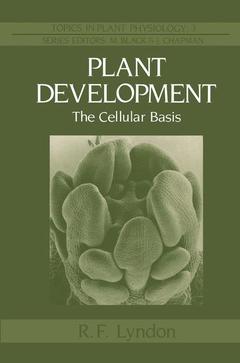I Development of the Basic Structures.- 1 The problems of development: embryogenesis.- 1.1 The problems of development.- 1.2 Changes in gene expression.- 1.3 Embryogenesis — the problems exemplified.- 1.4 Summary.- General reading.- Further reading.- Notes.- II Iterative Growth: Meristem Structure and Functioning.- 2 Root and shoot meristems: structure and growth.- 2.1 Module production.- 2.2 Meristemorganization.- 2.3 How is the rate of cell division controlled in meristems?.- 2.4 Summary.- Further reading.- Notes.- 3 Meristem functioning: formation of branches, leaves, and floral organs.- 3.1 Formation of branches.- 3.2 Leaf initiation.- 3.3 Changes in primordial initiation on flowering.- 3.4 Summary.- Further reading.- Notes.- III Control of Shape and Directions of Growth: The Cellular Basis of Form.- 4 Shape, growth directions, and surface structure.- 4.1 Maintenance of shape.- 4.2 The structural basis of axiality.- 4.3 Formation of a new axis and changes of growth direction.- 4.4 Surface structure and primordium formation.- 4.5 Summary.- Further reading.- Notes.- 5 Control of the plane of cell division.- 5.1 Cell division and its relation to the growth axis.- 5.2 Are changes in the shape of plant parts correlated with differential rates or planes of cell division?.- 5.3 Is the direction of growth determined by the plane of cell division, or is the plane of cell division consequential on the direction of growth?.- 5.4 Factors orientating the plane of cell division.- 5.5 Unequal cell divisions.- 5.6 The role of the cytoskeleton.- 5.7 The cytoskeleton and the plane of cell division.- 5.8 Summary.- Further reading.- Notes.- 6 The cellular basis of polarity.- 6.1 Development of polarity in Fucus and Pelvetia zygotes.- 6.2 Polarity in other cells — ion currents.- 6.3 Changing the polarity of growth.- 6.4 Polarity in unequal divisions.- 6.5 Polarity in tip growth.- 6.6 Polarity of growth in individual, isolated cells.- 6.7 Summary.- Further reading.- Notes.- IV Cell Differentiation.- 7 Control of the differentiation of vascular tissues.- 7.1 Regeneration of vascular tissues in wounded plants.- 7.2 Formation of xylary elements in culture and cell suspensions.- 7.3 Induction of vascular tissues in callus: formation of nodules.- 7.4 Does cell differentiation require specific concentrations of inducers?.- 7.5 Differentiation of xylem and phloem: can either form alone?.- 7.6 Induction of vascular strands.- 7.7 Secondary vascular tissues.- 7.8 Summary.- Further reading.- Notes.- 8 Cell enlargement, maturation, and differentiation.- 8.1 Limits of cell division.- 8.2 Cell enlargement and maturation.- 8.3 Cell differentiation.- 8.4 Summary.- Further reading.- Notes.- 9 Genes and development.- 9.1 Genic regulation of development.- 9.2 Gene expression during development.- 9.3 Induced changes in genes governing development.- 9.4 Growth substances and the control of gene expression.- 9.5 Summary.- Further reading.- Notes.- V Competence and Determination.- 10 Competence and determination in differentiation.- 10.1 Commitment.- 10.2 Is there such a thing as an undetermined cell?.- 10.3 Determination in callus and at the cellular level.- 10.4 Competence and determination in xylem cell differentiation.- 10.5 Competence and determination in bud initiation.- 10.6 Competence and determination in antheridium initiation in fern prothalli.- 10.7 Competence and determination in shoots and roots.- 10.8 Competence and determination in leaf development.- 10.9 The nature of determination.- 10.10 Summary.- Further reading.- Notes.- 11 Competence and determination in flowering.- 11.1 The transition to flowering.- 11.2 Commitment to flower in plants with juvenile phases — tobacco and blackcurrant.- 11.3 Effects of growth substances on determination in the grapevine.- 11.4 Determination in the flower.- 11.5 Determination in the flower as revealed by reversion.- 11.6 Determination in abnormal flower development.- 11.7 Flowering as changes in competence and determination.- 11.8 Summary.- Further reading.- Notes.- VI Coordination of Development.- 12 Pattern formation, positional information, and integration of growth.- 12.1 Spacing patterns of organs: phyllotaxis, lateral roots, branching.- 12.2 Patterns of tissues — blocking out of tissue patterns in meristems; why do some cells differentiate and not their neighbours?.- 12.3 Patterns of cells.- 12.4 Regeneration of pattern — positional information.- 12.5 Formation of pattern de novo and its physicochemical basis.- 12.6 Pattern formation within algal cells.- 12.7 Cell-cell communication.- 12.8 Integration of development: plants as fail-safe systems.- 12.9 Summary.- Further reading.- Notes.- References.




